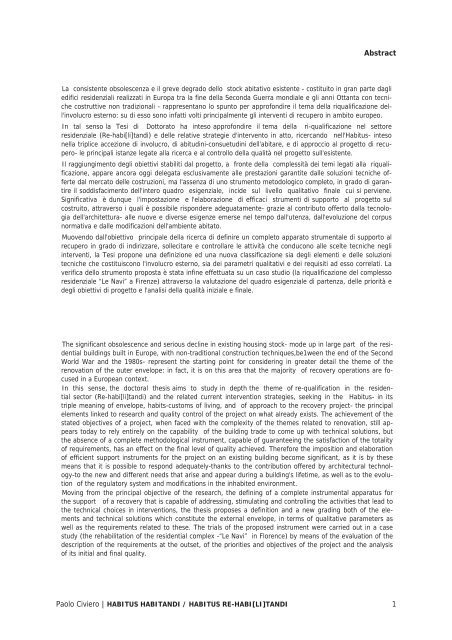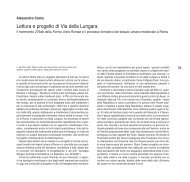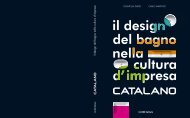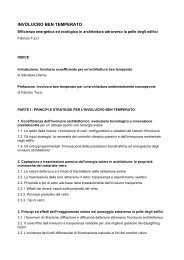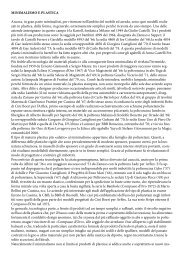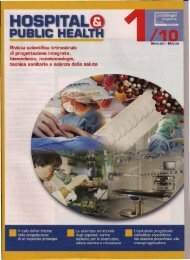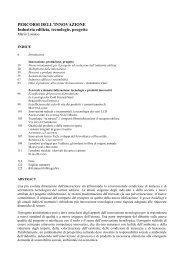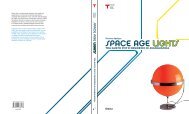Mostra/Apri - Facoltà di Architettura - Repository - Sapienza
Mostra/Apri - Facoltà di Architettura - Repository - Sapienza
Mostra/Apri - Facoltà di Architettura - Repository - Sapienza
You also want an ePaper? Increase the reach of your titles
YUMPU automatically turns print PDFs into web optimized ePapers that Google loves.
Abstract<br />
La consistente obsolescenza e il greve degrado dello stock abitativo esistente - costituito in gran parte dagli<br />
e<strong>di</strong>fici residenziali realizzati in Europa tra la fine della Seconda Guerra mon<strong>di</strong>ale e gli anni Ottanta con tecniche<br />
costruttive non tra<strong>di</strong>zionali - rappresentano lo spunto per approfon<strong>di</strong>re il tema della riqualificazione dell'involucro<br />
esterno: su <strong>di</strong> esso sono infatti volti principalmente gli interventi <strong>di</strong> recupero in ambito europeo.<br />
In tal senso la Tesi <strong>di</strong> Dottorato ha inteso approfon<strong>di</strong>re il tema della ri-qualificazione nel settore<br />
residenziale (Re-habi[li]tan<strong>di</strong>) e delle relative strategie d'intervento in atto, ricercando nell'Habitus- inteso<br />
nella triplice accezione <strong>di</strong> involucro, <strong>di</strong> abitu<strong>di</strong>ni-consuetu<strong>di</strong>ni dell'abitare, e <strong>di</strong> approccio al progetto <strong>di</strong> recupero-<br />
le principali istanze legate alla ricerca e al controllo della qualità nel progetto sull'esistente.<br />
Il raggiungimento degli obiettivi stabiliti dal progetto, a fronte della complessità dei temi legati alla riqualificazione,<br />
appare ancora oggi delegata esclusivamente alle prestazioni garantite dalle soluzioni tecniche offerte<br />
dal mercato delle costruzioni, ma l'assenza <strong>di</strong> uno strumento metodologico completo, in grado <strong>di</strong> garantire<br />
il sod<strong>di</strong>sfacimento dell'intero quadro esigenziale, incide sul livello qualitativo finale cui si perviene.<br />
Significativa è dunque l'impostazione e l'elaborazione <strong>di</strong> efficaci strumenti <strong>di</strong> supporto al progetto sul<br />
costruito, attraverso i quali è possibile rispondere adeguatamente- grazie al contributo offerto dalla tecnologia<br />
dell'architettura- alle nuove e <strong>di</strong>verse esigenze emerse nel tempo dall'utenza, dall'evoluzione del corpus<br />
normativa e dalle mo<strong>di</strong>ficazioni dell'ambiente abitato.<br />
Muovendo dall'obiettivo principale della ricerca <strong>di</strong> definire un completo apparato strumentale <strong>di</strong> supporto al<br />
recupero in grado <strong>di</strong> in<strong>di</strong>rizzare, sollecitare e controllare le attività che conducono alle scelte tecniche negli<br />
interventi, la Tesi propone una definizione ed una nuova classificazione sia degli elementi e delle soluzioni<br />
tecniche che costituiscono l'involucro esterno, sia dei parametri qualitativi e dei requisiti ad esso correlati. La<br />
verifica dello strumento proposta è stata infine effettuata su un caso stu<strong>di</strong>o (la riqualificazione del complesso<br />
residenziale “Le Navi” a Firenze) attraverso la valutazione del quadro esigenziale <strong>di</strong> partenza, delle priorità e<br />
degli obiettivi <strong>di</strong> progetto e l'analisi della qualità iniziale e finale.<br />
The significant obsolescence and serious decline in existing housing stock- mode up in large part of the residential<br />
buil<strong>di</strong>ngs built in Europe, with non-tra<strong>di</strong>tional construction techniques,be1ween the end of the Second<br />
World War and the 1980s- represent the starting point for considering in greater detail the theme of the<br />
renovation of the outer envelope: in fact, it is on this area that the majority of recovery operations are focused<br />
in a European context.<br />
In this sense, the doctoral thesis aims to study in depth the theme of re-qualification in the residential<br />
sector (Re-habi[li]tan<strong>di</strong>) and the related current intervention strategies, seeking in the Habitus- in its<br />
triple meaning of envelope, habits-customs of living, and of approach to the recovery project- the principal<br />
elements linked to research and quality control of the project on what already exists. The achievement of the<br />
stated objectives of a project, when faced with the complexity of the themes related to renovation, still appears<br />
today to rely entirely on the capability of the buil<strong>di</strong>ng trade to come up with technical solutions, but<br />
the absence of a complete methodological instrument, capable of guaranteeing the satisfaction of the totality<br />
of requirements, has an effect on the final level of quality achieved. Therefore the imposition and elaboration<br />
of efficient support instruments for the project on an existing buil<strong>di</strong>ng become significant, as it is by these<br />
means that it is possible to respond adequately-thanks to the contribution offered by architectural technology-to<br />
the new and <strong>di</strong>fferent needs that arise and appear during a buil<strong>di</strong>ng's lifetime, as well as to the evolution<br />
of the regulatory system and mo<strong>di</strong>fications in the inhabited environment.<br />
Moving from the principal objective of the research, the defining of a complete instrumental apparatus for<br />
the support of a recovery that is capable of addressing, stimulating and controlling the activities that lead to<br />
the technical choices in interventions, the thesis proposes a definition and a new gra<strong>di</strong>ng both of the elements<br />
and technical solutions which constitute the external envelope, in terms of qualitative parameters as<br />
well as the requirements related to these. The trials of the proposed instrument were carried out in a case<br />
study (the rehabilitation of the residential complex -“Le Navi” in Florence) by means of the evaluation of the<br />
description of the requirements at the outset, of the priorities and objectives of the project and the analysis<br />
of its initial and final quality.<br />
Paolo Civiero | HABITUS HABITANDI / HABITUS RE-HABI[LI]TANDI<br />
1


